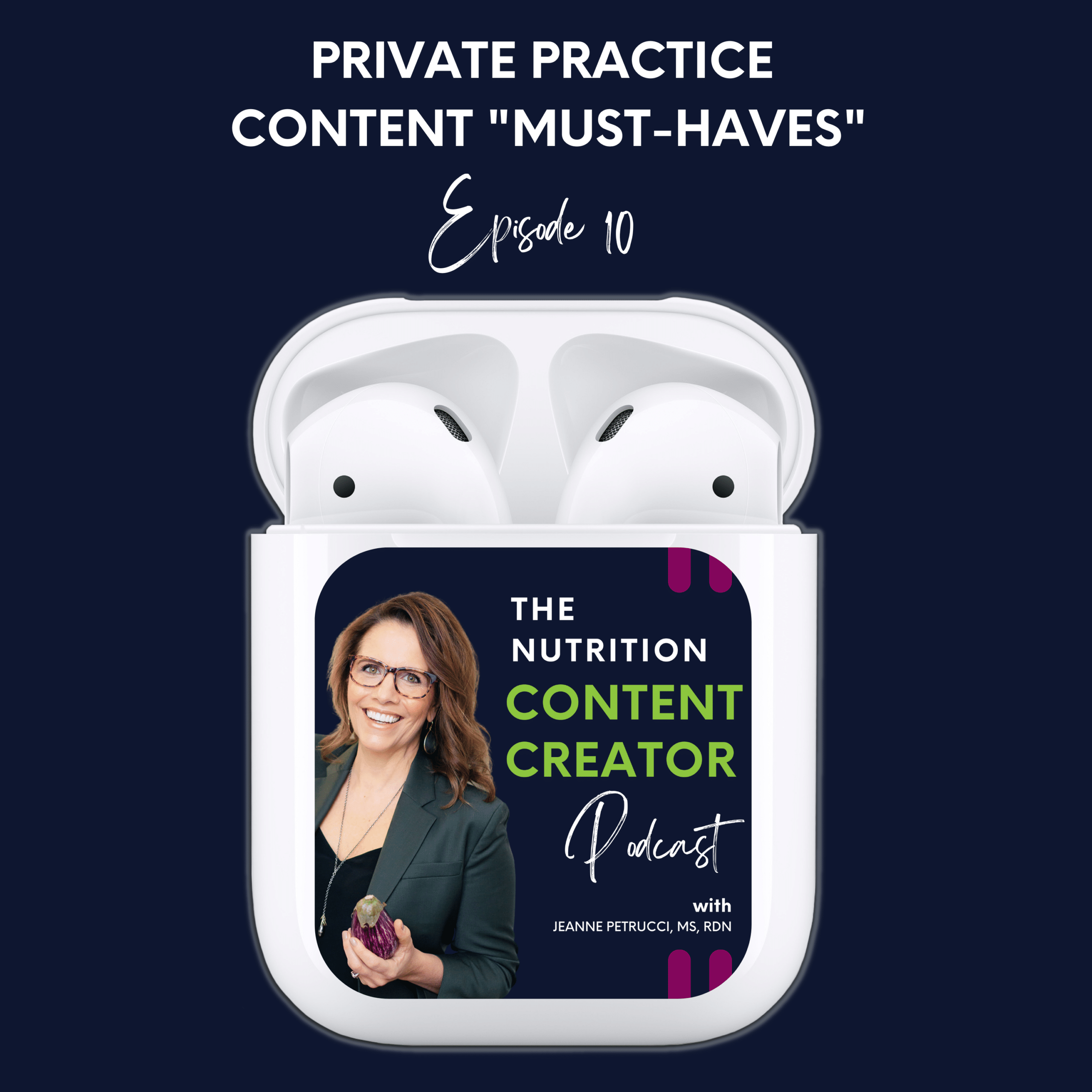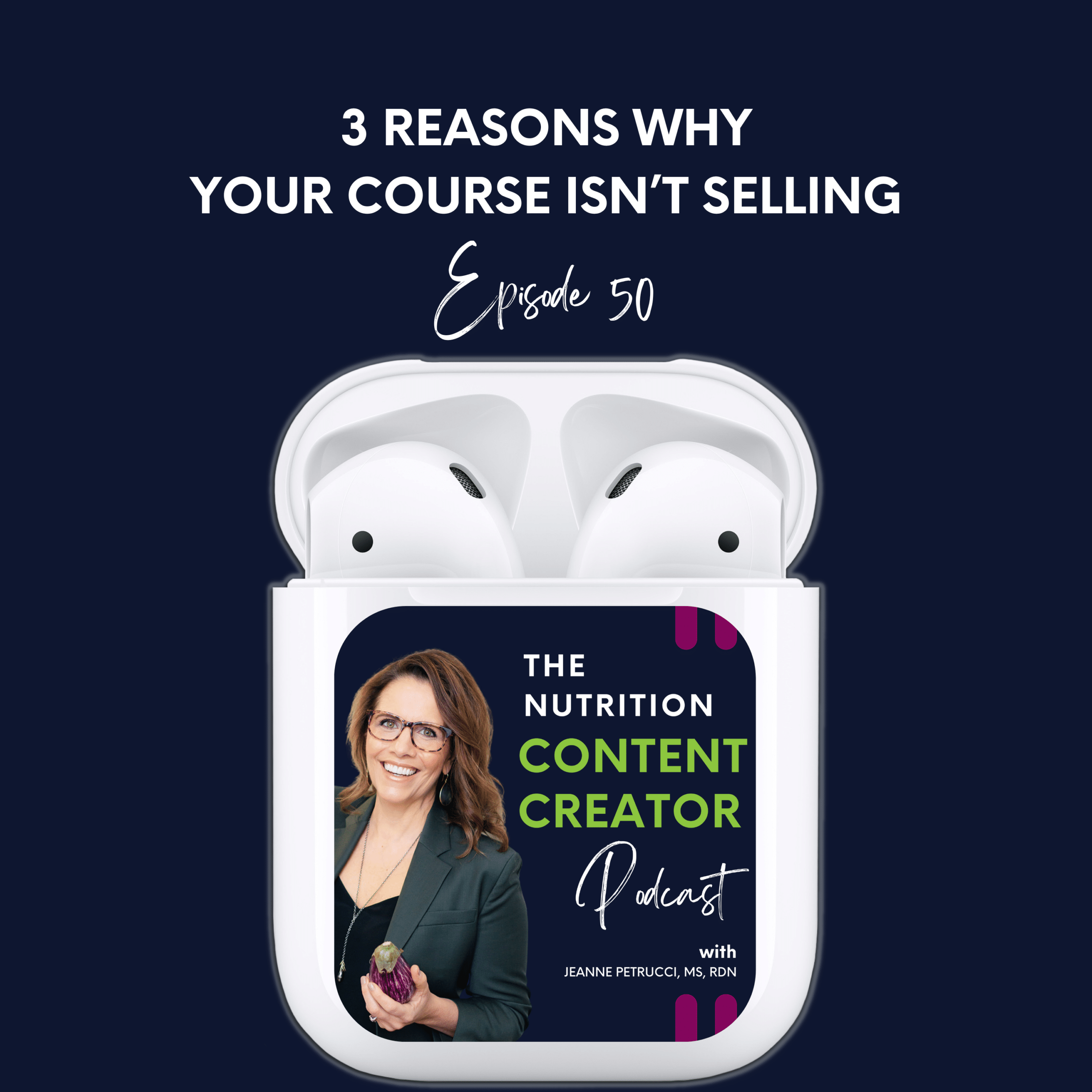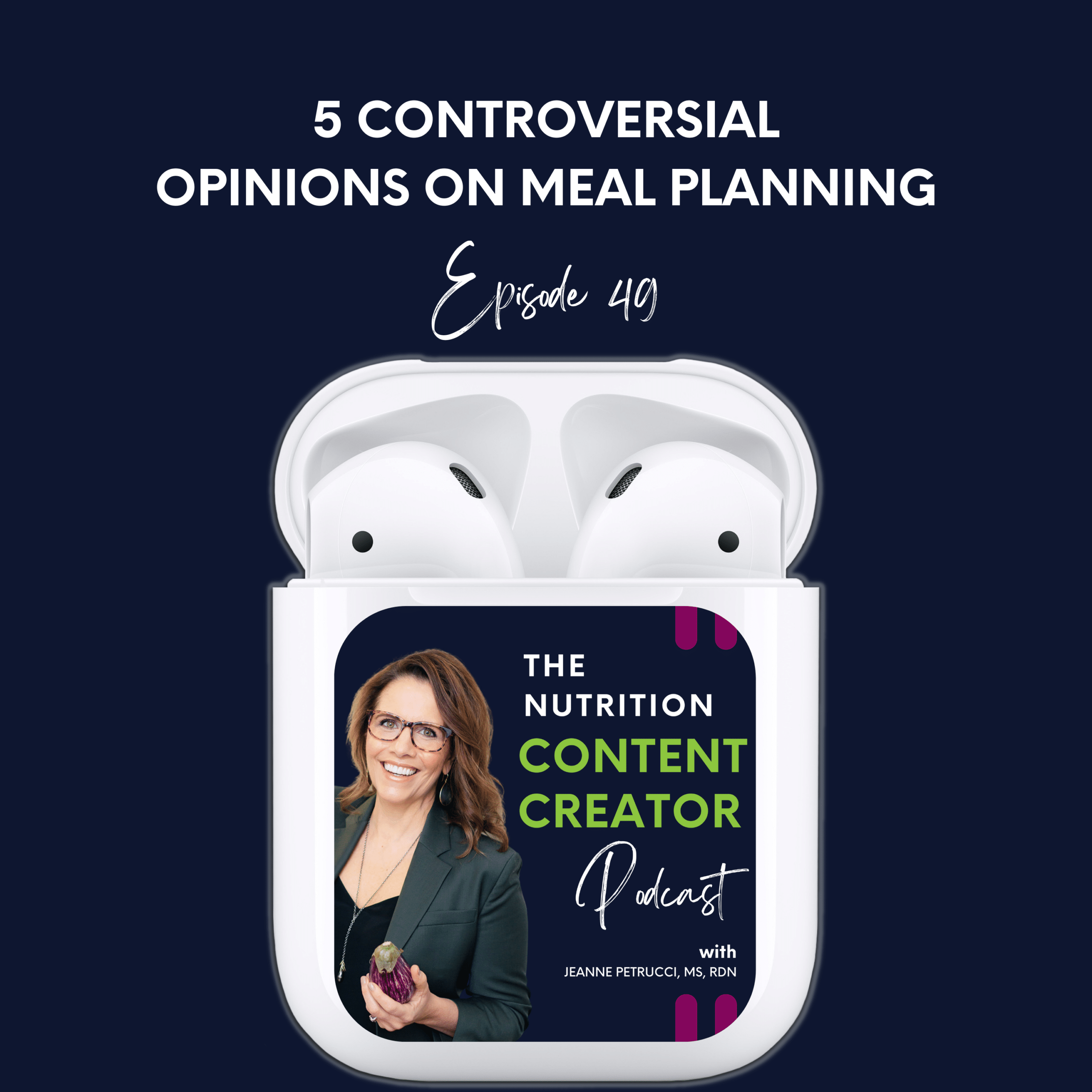10. Private Practice Content “Must-Haves”

As most of you may already know, I didn’t start my professional career as a Registered Dietitian doing what I do now. I began as a private practice dietitian fresh out of my internship. I opened the doors to my private practice almost seven years ago, and I can still vividly remember that day. Was I excited? Sure. I had worked hard for more than eight years to get ready for that moment. I completed four years of undergraduate prerequisites, three years of graduate school, and a one-year unpaid dietetic internship. I envisioned serving my community with all my soul, pouring everything I had learned about nutrition and behavior change into the services I would offer at LivingPlate Rx. Like you, I just wanted to help people. However, my simple vision of helping others required a not-so-simple foundation. I quickly realized that nutrition counseling and coaching were just the tip of the iceberg. To serve my clients with integrity, comply with healthcare regulations, and grow my practice, I needed a wealth of content. Today, I want to share with you the “must-haves” for a nutrition coaching practice. By having these essential pieces of content in place, you will establish a solid foundation for your practice’s growth and gain the confidence needed to serve your community at the highest level possible. Let’s dive in and explore the crucial pieces that form the backbone of a successful nutrition coaching practice. We’ll cover:
- The essential content components that will elevate your nutrition coaching practice
- Foundational content
- Core practice content
- Growth content
Where to Start?
Let’s start by understanding what being in “private practice” entails. In its simplest form, a private practice is typically a self-employed nutrition expert or group of experts who offer nutrition coaching and health advice to individual clients or groups. This can cover a broad range of services, including one-on-one nutritional counseling, group nutrition education, cooking classes, meal planning services, and even developing wellness programs for businesses. As nutrition professionals, we have this incredible body of knowledge that covers a wide spectrum of health conditions and diets. But here’s the thing – you can’t serve everyone with generic content. When you try to cover too many areas with your content, your message gets diluted, and you fail to attract clients who would truly benefit from your expertise. The answer to this is finding your niche and creating content specific to it. Finding your niche is about identifying your specialty and will be your guiding light for creating the content we’ll talk about today – even your intake forms. So, if you have not yet zeroed in on specifically who you are serving, don’t take any action yet. You can find more guidance on discovering your niche in Episode #1. Once you’ve determined your area of interest, you can then move forward to develop practice materials that cater to this specific audience. If your niche is your guiding light, then your unique selling proposition (USP) is your compass. It’s the unique value you bring to your clients that differentiates you from other nutrition professionals in your field. Maybe you have a unique methodology, a distinct blend of services, or perhaps your health journey that’s led you to this path. Whatever it is, this unique aspect of who you are and how you practice will permeate all practice materials. For guidance on developing your unique value proposition, be sure to listen to Episode #4, Create a Blue Ocean, and complete the exercises as part of the Content Cure for that episode. You really cannot take one more step forward without this as part of your foundation. It is your compass and without it, you’ll lose direction. And sometimes it’s not about creating a sparkly new offer before creating a new product, service, or offer, you may want to improve your client retention first. One of your Key Performance Indicators for your practice should be tracking the ratio of returning clients to new clients. Why? Because having a healthy balance is the best way to support predictable income.
Foundational Content
Let’s dig into the essential paperwork, tools, and regulatory compliance you need to have in place before you even “open your doors” for business.
Website
Today, having a basic online presence is non-negotiable. Your website is like your digital storefront. It’s how people find you, learn about you, and ultimately decide whether they want to work with you. Your website should communicate your USP, the services you offer, and how potential clients can book a consultation with you. You can also showcase client testimonials and run a blog where you share valuable content that can attract and engage your target audience. You can build it yourself, but if your vision is to grow your business on a foundation of professionalism, this may be the first investment you make – hire a professional who can not only execute the actual build of your website but can support you with your messaging. As someone who has been through several website rebuilds, it’s best to select someone who has experience in your market. Pricing will certainly come into play when making this decision but I encourage you to evaluate sites they have built for others in your field before making a decision. Do these sites reflect how you want to be perceived? If your site looks “homemade”, is difficult to navigate, is built on a template, or the messaging is off, potential clients will lose confidence in your ability to serve them. Your website needs to be your best foot forward and should not be an afterthought or just a pretty page with generic messaging. Lastly, your website will need Terms and Privacy and Disclosure statements. While you can obtain templates from a variety of sources I strongly encourage you to have an attorney, who represents you, review and edit these documents for use on your site. Even though these documents are rarely viewed and are tucked in small print at the bottom of most sites, they are not insignificant. Like my attorney frequently reminds me, “You won’t have a problem until you have a problem and you’re not prepared.”
Practice Documents
Now we’ll cover the crucial pieces of documentation needed for running a smooth practice. The intake forms, privacy policies, terms of service, and informed consent forms. Let’s break these down. Intake forms: These are your first formal interaction with your clients. Intake forms help gather important information about your client’s health history, current health status, nutrition and lifestyle habits, and goals for seeking your services. They are a crucial tool to understand your client better and design a personalized plan for them. Your intake forms should reflect the services you offer and the niche you serve. For example, as a culinary-focused practitioner, you’ll want to include a culinary confidence assessment. If you are going to coach someone on meeting their health goals with food you’ll need to understand their kitchen confidence level. If you serve people with a history of eating disorders, you’ll want your intake form that includes this important information. Part of the intake process is often asking clients and patients to document their dietary intake – typically a 3-day dietary recall. These are notoriously difficult for clients as they often don’t remember what they ate and can feel judged. The solution here is to bring in a validated dietary recall tool like the one we use, VioScreen. Privacy policies and terms of service: These are legal documents that outline how you handle your clients’ data and what terms and conditions apply when they use your services, including payment policy. Privacy policies are especially important because you handle sensitive health information, and clients need to know that their information is safe with you. Payment policies are included in your terms of service and should be clear about expectations [for example, cancelation policy and insurance reimbursements.] Informed consent forms: Before you begin your nutrition counseling, it’s important to obtain written informed consent from your clients. This ensures that they understand and agree to the process of your work together, including the nature and limits of your services, their right to confidentiality, and their responsibility in the counseling process. Privacy policies, terms of service, and consent forms, like the Terms and Privacy policies you have on your website, should also be reviewed by your attorney.
Compliance Documents and Software
Whenever you are exchanging information and having a conversation related to someone’s health, you need to follow HIPAA rules. HIPAA stands for the Health Insurance Portability and Accountability Act. HIPAA is a law that provides privacy standards to protect patients’ medical records and other health information provided to health plans, doctors, hospitals, and other healthcare providers. Your practice needs to adhere to these standards. If you plan to use any kind of electronic health records system, you’ll need to ensure that these platforms are HIPAA-compliant. Here’s something most people don’t understand: Using a HIPAA-compliant piece of software does NOT make your practice HIPAA-compliant. You also need to behave in a way that is HIPAA-compliant so be sure you understand the details by completing HIPAA training. Registered Dietitians are required to complete this as part of their training – if you have not already done so, I strongly recommend that you and anyone in your practice who will be handling sensitive personal health information complete the training for a certificate. You can do this at HIPAAtraining.com. In terms of practice management software, there are a plethora of options available. From managing appointments, sending reminders, and handling billing and invoices, to secure video calls for telehealth sessions, good practice management software can help you streamline your processes and ensure you stay organized and efficient. Begin with a trial of a few and decide which is best for you long-term, keeping in mind your growth plan. Starting with your longer-term vision in mind will prevent you from having to switch over to a different platform as you expand [I learned the hard way!] And finally, keep in mind that this is just the tip of the iceberg. Starting and growing a private practice involves continuous learning, adapting, and refining your processes. It can be overwhelming at times, but remember, you don’t have to do it alone. Leverage your network [this community], seek advice from those who’ve done it before, and consider hiring experts like accountants or lawyers to help navigate the more complex aspects. The latter is money well-spent.
Core Practice Content
This is where I LOVED spending my time when I was in private practice and it’s what I now do full-time – developing content that fuels practice growth by attracting, serving, and retaining practice clients. There is no way you can create all the content you need from scratch, serve your clients with integrity, scale practice, and have a life. Something will have to give. Remember, it’s either time or money and if you do this all yourself, you will almost certainly run out of time and energy. So invest in resources that can support you – doing this will not only set you free to serve your clients with the utmost professionalism but will improve your quality of life. Here are essential categories and examples of core content for your practice:
Patient education materials
These are a vital part of your practice. They not only equip your clients with the knowledge to manage their health independently, but they also serve to reinforce your counseling sessions. This category includes ebooks, handouts, and infographics. All of these materials should reflect your unique approach to nutrition and represent the latest, evidence-based knowledge in an accessible, digestible manner.
Patient “action” materials and resources
This includes materials that guide your patients’ daily actions toward their health goals. Examples of this could be personalized meal plans delivered through a digital platform, shopping guides tailored to their dietary needs, and curated recipe books that align with their nutritional prescription. By providing these, you’re giving your clients a roadmap to success.
Community support content
This category covers all the content you create to foster a supportive community for your clients. This could be a private Facebook group where you share motivational tips, challenges, and Q&A sessions. The content for this group should address collective, shared barriers your clients face and provide solutions. It’s also a space to celebrate wins and inspire one another, thereby reducing client attrition and increasing satisfaction. Remember, while creating all these content pieces, your USP (Unique Selling Proposition) should shine through. It’s what sets you apart and attracts clients who resonate with your approach. Episode #5 will guide you to creating a rock-solid USP.
Growth Content
In addition to the core content we discussed, you should consider incorporating the following types of content to further grow your practice and serve your clients and patients: Community Partner Content: Building relationships with other businesses or practitioners in your community can be a powerful way to reach more people. This could include content such as guest blogs or joint webinars with a local fitness center, collaborative events with a healthy food store, or providing nutrition content for a local school’s newsletter. These partnerships not only extend your reach but also solidifies your place as a trusted authority in your community. If you partner with interdisciplinary practitioners and businesses in your community, information available in their offices can drive business. For example, create a flier with a QR code people can take a picture of to reach out to you and place it in a lucite stand in the waiting rooms of physician offices. This is a bit old-school but it is effective. Referral form: This had a profound impact on our growth when we first got started and continued to add new clients to our roster monthly. A referral form is given to your interdisciplinary partners [physicians for example] and used to refer clients to you. They include key patient information, insurance coverage, diagnoses, and recommended nutrition prescriptions [for example, anti-inflammatory, low-glycemic, low-FODMAP diets]. This form is faxed to you via HIPAA-compliant software. If you are a Living Plate Rx member, we have created this form for you along with a protocol for how to use the form to drive business. It can be found in your Business Tool Collection of your library. Workshop and Webinar Content: Conducting workshops or webinars on various health topics can be an excellent way to engage your current clients and attract potential new ones. These platforms can serve as an opportunity for you to share your expertise and give attendees a taste of your services. Plus, the content for these can later be repurposed into blog posts, infographics, or social media posts. Social Proof Content: Client Testimonials and Success Stories. Genuine testimonials and success stories from your clients can be very compelling content. It provides social proof of the quality and effectiveness of your services, which can greatly influence prospective clients. Email Marketing Content: Email is a direct line of communication with your clients and prospects. Creating content for regular email newsletters, personalized health tips, and reminders can help keep you at the top of your client’s minds. It’s also a way to provide additional value and support outside of appointments. Video Content: Whether it’s quick nutrition tips, recipe demonstrations, or client testimonials, video content can be very engaging. Consider using platforms like YouTube, IGTV, or Facebook Live to connect with your audience in a more personal and interactive way. Podcast Content: Hosting a podcast can position you as an authority in your field. You could discuss different health topics, interview other health professionals, or even do Q&A sessions with listeners. Podcasts are an excellent way to engage your audience during their commutes, workouts, or downtime. Content Collaborations: Partner with like-minded professionals or influencers in your field for content collaborations. This could be guest posting on each other’s blogs, appearing on each other’s podcasts, or co-hosting webinars. These collaborations can introduce you to a wider audience and bring fresh perspectives to your content. Remember, all content should be created with your audience in mind. Always ask yourself what your clients or prospective clients would find valuable and informative. Stay consistent, authentic, and remember to make your content actionable – that’s what will keep your audience coming back for more.
Content Cure for the Week
I am providing you with Your Ultimate Guide to Essential Private Practice Content, a 17-page guide that summarizes our conversation here. >>CLICK HERE TO DOWNLOAD YOUR GUIDE<< Your goal for this week is to review the guide and the content, assess what you already have in place, and start filling in those areas where your practice content might be less robust. Creating a body of content for your practice takes time. If you are a Living Plate Rx member, you have access to all the content you need but you still need to evaluate what content to use to support your business and client goals considering your niche. The journey of building and growing your private practice is as unique as the nutrition plans you provide for your patients. It’s a path filled with learning, adaptation, and growth. While it can seem daunting at first, remember that you’re not alone in this journey. Just like you, every successful nutrition professional in private practice started somewhere. As a member of our community, you have thousands of like-minded practitioners cheering you on so be sure to join our private Facebook group, Scale Your Nutrition Practice. And remember, our primary mission as nutrition professionals is to empower people with the knowledge and tools they need to live their healthiest lives. The content you create plays a crucial role in fulfilling that mission. It’s how you share your expertise, demonstrate your value, and connect with those you wish to serve.
Key Takeaway
- Foundational content: this category of content includes intake forms, privacy policies, and informed consent forms. These forms do not need to be generic – take time to ensure that they reflect the community you serve and how you serve them
- Core Practice Content: this category includes patient education and “action” materials like handouts, meal plans, and cooking videos that you use directly with clients and also extends to content outside your practice such as community support and collaborative partner materials.
- Growth Content: this category includes content that fuels practice growth such as community partner content, social media, emails, webinars, video content on platforms such as Facebook and YouTube, and audio content such as podcasts

Jeanne Petrucci MS RDN
Founder, Expert Nutrition Content Creator


